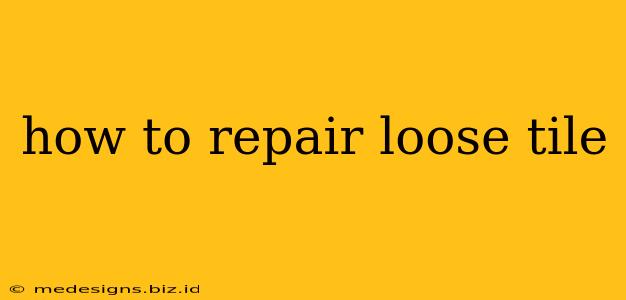Loose tiles are a common household problem, but thankfully, fixing them is often a manageable DIY project. Whether it's a single rogue tile in your bathroom or a cluster in your kitchen, this guide will walk you through the process of repairing loose tiles effectively and restoring the integrity of your tiled surfaces. We'll cover everything from identifying the problem to choosing the right tools and materials, ensuring you achieve a professional-looking finish.
Identifying the Problem: Why are My Tiles Loose?
Before you grab your tools, it's crucial to understand why your tiles are loose. This will determine the best repair method. Common causes include:
- Poor Initial Installation: The most common reason is inadequate adhesive during the initial tiling job. This is especially true for older installations.
- Water Damage: Water infiltration behind the tiles can weaken the adhesive bond, causing them to loosen. This is particularly prevalent in bathrooms and kitchens.
- Movement in the Subfloor: Shifting or settling in the underlying structure can put stress on the tiles and adhesive, leading to loosening.
- Improper Grouting: While not a direct cause of loose tiles, poor grouting can contribute to instability and make the problem worse.
Tools and Materials You'll Need:
Gathering the right materials is essential for a successful repair. You'll likely need:
- Chisel and hammer (or a tile pry bar): For carefully removing loose tiles if necessary.
- Putty knife or scraper: For cleaning away old adhesive and grout.
- Vacuum cleaner or brush: To remove debris.
- Tile adhesive (thin-set mortar): Choose a high-quality adhesive appropriate for your tile type and location.
- Grout (matching existing grout): To fill the gaps between tiles once the loose tile is repaired.
- Grout float: For applying and smoothing the grout.
- Sponge: For cleaning excess grout.
- Bucket of water: For rinsing the sponge.
- Measuring tape: To ensure you have enough adhesive and grout.
- Safety Glasses: Protect your eyes from flying debris.
- Gloves: Protect your hands.
Step-by-Step Repair Process:
1. Preparation is Key:
- Assess the Damage: Carefully examine the loose tiles and the surrounding area. Determine the extent of the problem.
- Clean the Area: Thoroughly clean the area around the loose tile(s) removing any loose grout, dirt, or debris. A vacuum cleaner is ideal for this.
2. Removing the Loose Tile (If Necessary):
- Gently Pry: If the tile is significantly loose, carefully pry it up using a chisel and hammer or tile pry bar. Work slowly and avoid damaging surrounding tiles. If the tile is cracked or broken, you'll need to replace it entirely.
3. Preparing the Tile and Surface:
- Clean the Back of the Tile: If reusing the tile, clean the back of the tile thoroughly to remove any old adhesive.
- Prepare the Surface: Clean the area on the substrate where the tile will be re-adhered. Remove any old, loose adhesive.
4. Applying the Adhesive:
- Apply Thin-Set Mortar: Apply a thin layer of thin-set mortar to the back of the tile and spread it evenly. Ensure the adhesive covers the entire back surface.
5. Reattaching the Tile:
- Press Firmly: Press the tile firmly into place, ensuring it's level with the surrounding tiles. Use spacers if necessary.
6. Grouting (If Necessary):
- Apply Grout: Once the adhesive has dried (check the manufacturer's instructions), apply grout to the gaps between tiles using a grout float.
- Clean Excess Grout: Immediately clean away excess grout with a damp sponge, being careful not to dislodge the newly applied grout.
7. Finishing Touches:
- Allow to Dry: Allow the grout to dry completely according to the manufacturer's instructions. Then, seal the grout to prevent future water damage and staining.
Preventing Future Loose Tiles:
- Regular Cleaning and Maintenance: Regularly clean your tiled surfaces to prevent the buildup of dirt and grime that could compromise the bond.
- Address Water Damage Promptly: Fix any leaks or water damage immediately to prevent further damage to the tiles and adhesive.
- Proper Ventilation: Ensure adequate ventilation in areas prone to moisture, such as bathrooms and kitchens.
By following these steps, you can effectively repair loose tiles and extend the lifespan of your tiled surfaces. Remember, if you're uncomfortable tackling this DIY project, it’s always best to consult a professional tiler. They have the experience and tools to ensure a long-lasting and beautiful repair.
